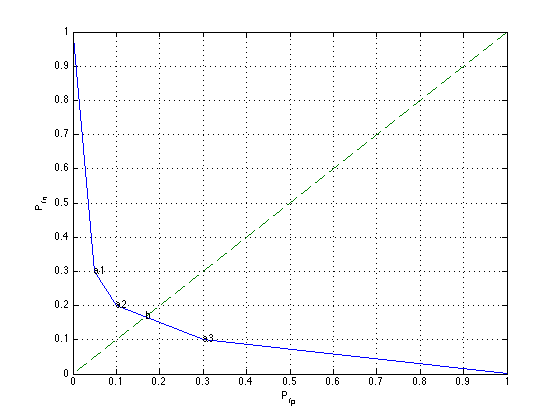P = [0.70 0.10
0.20 0.10
0.05 0.70
0.05 0.10];
[n,m] = size(P);
nopts = 1000;
weights = logspace(-5,5,nopts);
obj = [0;1];
inds = ones(n,1);
next = 2;
for i = 1 : nopts,
PW = P * diag( [ 1 ; weights(i) ] );
[ maxvals, maxinds ] = max( PW' );
if (~isequal(maxinds', inds(:,next-1)))
inds(:,next) = maxinds';
T = zeros(m,n);
for j=1:n
T(maxinds(1,j),j) = 1;
end;
obj(:,next) = 1-diag(T*P);
next = next+1;
end;
end;
plot(obj(1,:), obj(2,:),[0 1], [0 1],'--');
grid on
for i=2:size(obj,2)-1
text(obj(1,i),obj(2,i),['a', num2str(i-1)]);
end;
cvx_begin
variables T( m, n ) D( m, m )
minimize max( D(1,2), D(2,1) )
subject to
D == T * P;
sum( T, 1 ) == 1;
T >= 0;
cvx_end
objmp = 1 - diag( D );
text( objmp(1), objmp(2), 'b' );
xlabel('P_{fp}'); ylabel('P_{fn}');
Calling SDPT3: 11 variables, 6 equality constraints
------------------------------------------------------------
num. of constraints = 6
dim. of linear var = 10
dim. of free var = 1 *** convert ublk to lblk
*******************************************************************
SDPT3: Infeasible path-following algorithms
*******************************************************************
version predcorr gam expon scale_data
NT 1 0.000 1 0
it pstep dstep pinfeas dinfeas gap prim-obj dual-obj cputime
-------------------------------------------------------------------
0|0.000|0.000|1.6e+01|1.3e+01|1.0e+03| 2.875957e-10 0.000000e+00| 0:0:00| chol 1 1
1|0.960|0.784|6.3e-01|2.9e+00|1.3e+02| 8.945382e+00 -3.154700e+01| 0:0:00| chol 1 1
2|1.000|0.972|1.2e-06|9.1e-02|1.6e+01| 6.618313e+00 -8.420478e+00| 0:0:00| chol 1 1
3|1.000|0.352|3.5e-07|6.0e-02|8.3e+00| 1.069569e+00 -6.764824e+00| 0:0:00| chol 1 1
4|1.000|0.911|1.8e-06|5.4e-03|7.6e-01| 4.837967e-01 -2.586458e-01| 0:0:00| chol 1 1
5|0.868|0.462|2.5e-07|2.9e-03|3.8e-01| 2.414092e-01 -1.231513e-01| 0:0:00| chol 1 1
6|1.000|0.693|8.5e-08|8.9e-04|1.1e-01| 1.874677e-01 8.179283e-02| 0:0:00| chol 1 1
7|1.000|0.591|6.2e-09|3.7e-04|3.9e-02| 1.691964e-01 1.312147e-01| 0:0:00| chol 1 1
8|0.989|0.952|1.9e-09|1.8e-05|1.8e-03| 1.667232e-01 1.649578e-01| 0:0:00| chol 1 1
9|0.989|0.989|1.1e-10|2.0e-07|2.1e-05| 1.666673e-01 1.666471e-01| 0:0:00| chol 1 1
10|0.989|0.989|2.4e-12|5.1e-07|3.8e-07| 1.666667e-01 1.666664e-01| 0:0:00| chol 1 1
11|1.000|0.989|6.8e-15|9.3e-09|8.6e-09| 1.666667e-01 1.666667e-01| 0:0:00|
stop: max(relative gap, infeasibilities) < 1.49e-08
-------------------------------------------------------------------
number of iterations = 11
primal objective value = 1.66666668e-01
dual objective value = 1.66666663e-01
gap := trace(XZ) = 8.62e-09
relative gap = 6.46e-09
actual relative gap = 4.40e-09
rel. primal infeas = 6.79e-15
rel. dual infeas = 9.32e-09
norm(X), norm(y), norm(Z) = 1.9e+00, 7.5e-01, 8.9e-01
norm(A), norm(b), norm(C) = 4.9e+00, 3.0e+00, 2.4e+00
Total CPU time (secs) = 0.12
CPU time per iteration = 0.01
termination code = 0
DIMACS: 1.0e-14 0.0e+00 1.1e-08 0.0e+00 4.4e-09 6.5e-09
-------------------------------------------------------------------
------------------------------------------------------------
Status: Solved
Optimal value (cvx_optval): +0.166667

